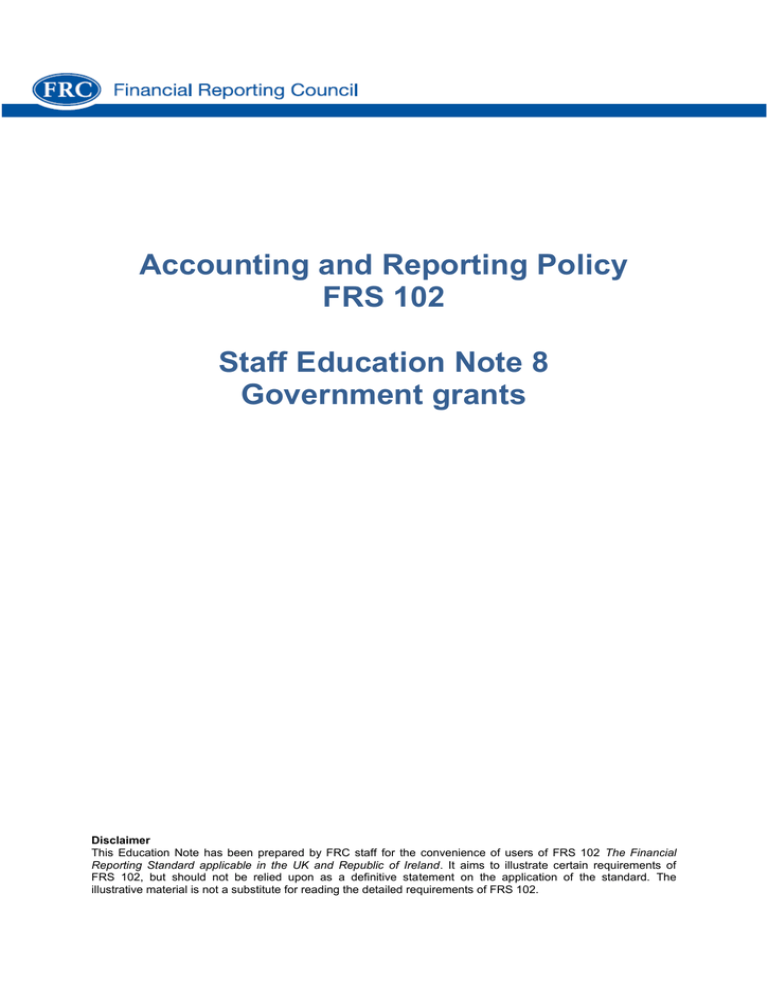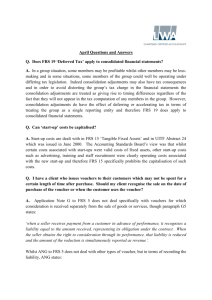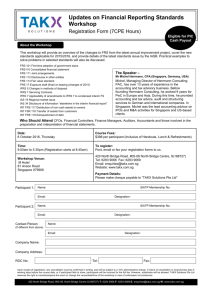Accounting and Reporting Policy FRS 102 Staff Education Note 8
advertisement

Accounting and Reporting Policy FRS 102 Staff Education Note 8 Government grants Disclaimer This Education Note has been prepared by FRC staff for the convenience of users of FRS 102 The Financial Reporting Standard applicable in the UK and Republic of Ireland. It aims to illustrate certain requirements of FRS 102, but should not be relied upon as a definitive statement on the application of the standard. The illustrative material is not a substitute for reading the detailed requirements of FRS 102. Staff Education Note 8: Government grants Contents Page Introduction 2 Recognition criteria 3 Example: Grant towards a fixed asset SSAP 4 4 FRS 102 4 Page | 1 Staff Education Note 8: Government grants Introduction This Staff Education Note compares the current accounting treatment for government grants under SSAP 4 Accounting for government grants and Section 24 Government Grants of FRS 102 Financial Reporting Standard applicable in the UK and Republic of Ireland. This Staff Education Note is written to highlight key areas of consideration when transitioning to FRS 102 and is not designed to be exhaustive. Page | 2 Staff Education Note 8: Government grants Recognition criteria SSAP 4 FRS 102 Government grants Requires grants to be accounted for either based on the performance model or the accrual model. a) should be recognised in the profit and loss account so as to match them with the expenditure towards which they are intended to contribute. b) made as a contribution towards fixed assets should be recognised over the expected useful economic lives of the related assets. c) made to finance the general activities of an enterprise over a specific period or to compensate for the loss of current or future income should be recognised in the profit and loss account of the period in respect of which they are paid. (FRS 102 paragraph 24.4) The performance model requires that: (a) A grant that does not impose specified future performance-related conditions on the recipient is recognised in income when the grant proceeds are received or receivable. (b) A grant that imposes specified future performance-related conditions on the recipient is recognised in income only when the performance-related conditions are met. (FRS 102 paragraph 24.5B) (SSAP 4 paragraph 23) In practice this might be seen as giving entities some flexibility over their accounting policies for the recognition of government grants. The accrual model requires that: a) An entity classifies a grant either as a grant relating to revenue or a grant relating to assets. b) Grants relating to revenue are recognised in income on a systematic basis over the periods in which the entity recognises the related costs for which the grant is intended to compensate. (Note: A grant that becomes receivable as compensation for expenses or losses already incurred or for the purpose of giving immediate financial support to the entity with no future related costs shall be recognised in income in the period in which it becomes receivable.) c) Grants relating to assets are recognised in income on a systematic basis over the expected useful life of the asset. (FRS 102 paragraphs 24.5C to 24.5F) Page | 3 Staff Education Note 8: Government grants Example Grant towards a fixed asset Facts A manufacturing company receives a government grant of £200,000 as an incentive to open a factory in a region of high unemployment. There are no further conditions associated with the grant, other than that it is used to pay for the construction of this factory. In the same year as receiving the grant, the company constructs the factory for a total cost of £600,000 and begins to use it. The company has a policy of depreciating buildings over a useful life of 50 years. SSAP 4 Under SSAP 4 (and taking into account company law), the grant is deferred and shown as a liability. It is then released to the profit and loss account over the expected useful life of the related asset. Given that the asset’s life is 50 years (and the company has no plans to relocate during this time), the entries are as follows: Recognition of the factory (fixed asset) Dr Fixed assets £600,000 Cr Cash £600,000 Initial recognition of the grant Dr Cash £200,000 Cr Deferred grants £200,000 Recognition of depreciation charge on the factory (£600,000 / 50 years) Dr Depreciation (P&L) £12,000 Cr Fixed assets £12,000 Release the grant to the P&L (£200,000 / 50 years) Dr Deferred grants £4,000 Cr P&L (grant income) £4,000 FRS 102 Performance model Under FRS 102, where the entity elects to apply the performance model, the whole grant is recognised in profit or loss immediately. This is because there are no provisions requiring deferral of the grant received, as the only condition was that the factory must be constructed and this condition has been fulfilled. Recognition of the factory (fixed asset) Dr Fixed assets £600,000 Cr Cash £600,000 Initial recognition of the grant Dr Cash £200,000 Cr Grant income (P&L) £200,000 Recognition of depreciation charge on the factory (£600,000 / 50 years) Dr Depreciation (P&L) £12,000 Cr Fixed assets £12,000 Page | 4 Staff Education Note 8: Government grants Note: If the fact pattern changed, this example may show a less stark difference between SSAP 4 and the performance model in accordance with FRS 102. For instance, if the company had an obligation to use the factory (and hence provide local employment) for a certain period following its construction, the grant would be recognised later. The mechanism for recognising the grant during the specified period would depend on the detailed terms and conditions, and would not necessarily be based on the expected useful life of the building. Accrual model Under FRS 102, where the entity elects to apply the accrual model, the accounting would be the same as SSAP 4. It should be noted that paragraph 2.52 of FRS 102 does not permit an entity to offset assets and liabilities, or income and expenses, unless required or permitted by the FRS, and that paragraph 24.5G of FRS 102 explicitly prohibits the deduction of a government grant relating to an asset from the carrying amount of the fixed asset. Page | 5



